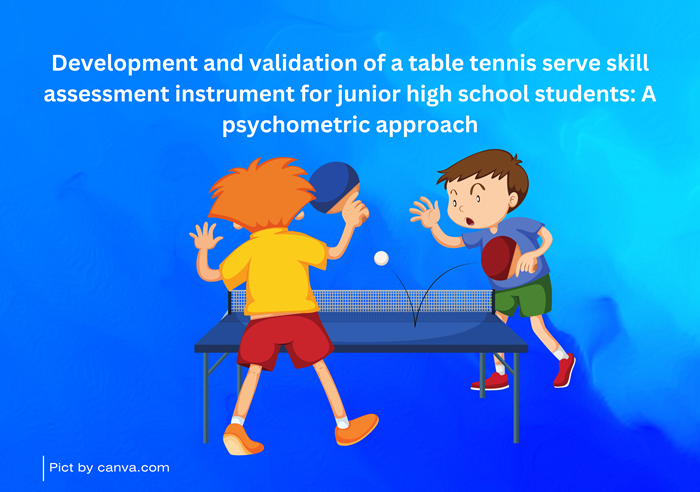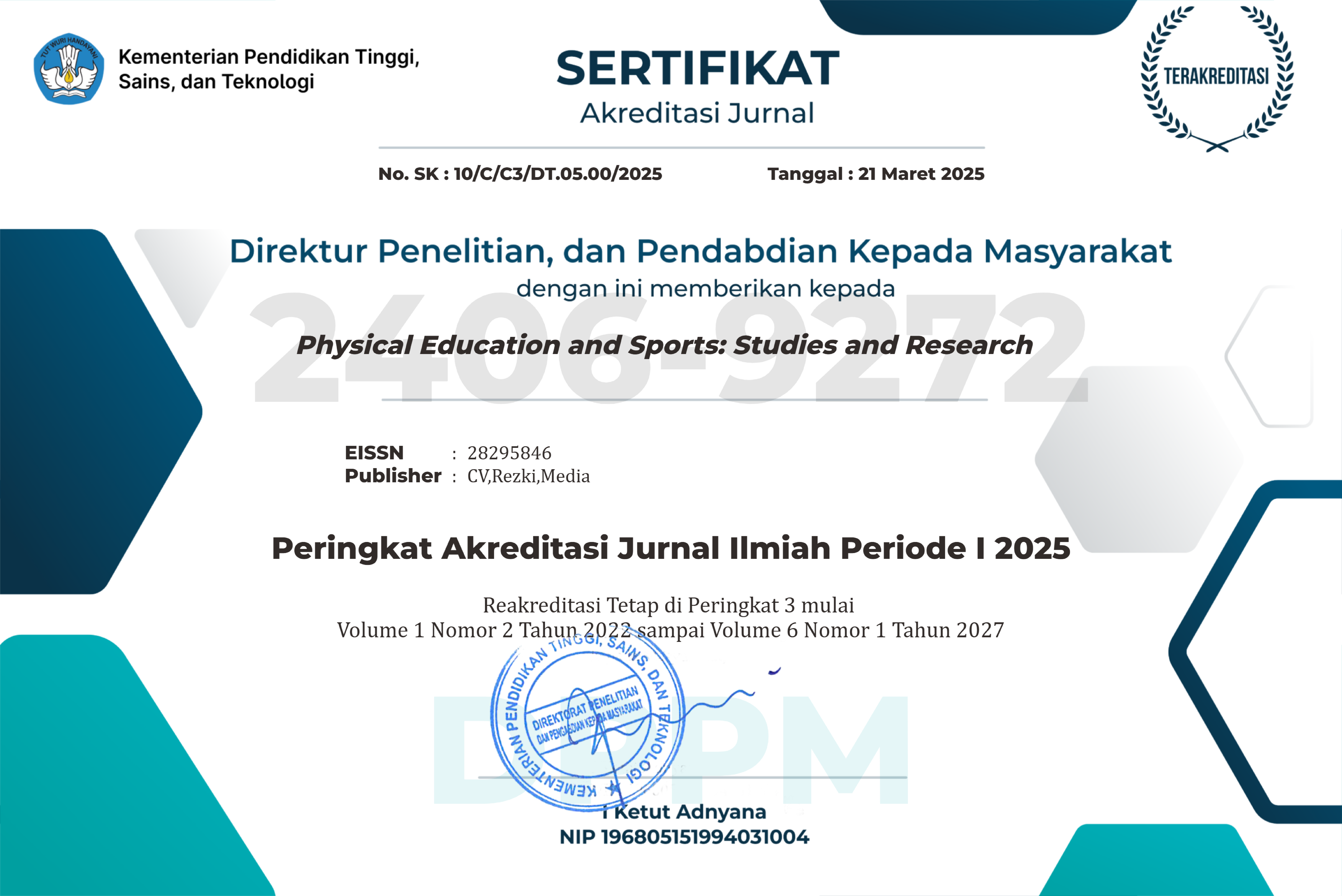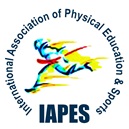Development and validation of a table tennis serve skill assessment instrument for junior high school students: A psychometric approach

Downloads
Background: The highest assessment weight in physical education lessons lies in psychomotor skills. In order to find out how far the competencies possessed by students, a clear and comprehensive assessment tool or instrument is needed.
Objectives: The research aims to develop a test instrument for forehand and backhand service skills in table tennis small ball games.
Methods: The development of this instrument uses a research and development scheme, with predetermined steps (1) determining objectives, (2) analyzing literature, (3) developing specifications, (4) administering, (5) conducting tests, (6) analyzing data validity, reliability, and objectivity. The cluster sampling procedure was conducted on students aged 13-15 who met the inclusion criteria, involving junior high school students (n=80), consisting of 41 female students and 39 male students. Data were analyzed using IBM SPSS Statistics version 11.0. The basis for decision-making is the Pearson correlation test. The analysis technique in the reliability test uses a test and retest external estimation approach.
Results: The forehand serve variable has a calculated r-value of 0.456> r-table 0.312, and the backhand serve variable obtained a calculated R-value of 0.352> r-table 0.312, so the table tennis skill instrument on that variable was declared valid. At the same time, the reliability test shows a value above 0.70; the instrument that has been prepared can be declared reliable.
Conclusions: The assessment instrument for forehand and backhand serve skills in table tennis games for junior high school students has met the validity and reliability criteria. This shows that the instrument is suitable for teachers as an objective and consistent measuring tool in evaluating basic table tennis skills in students. Recommendations for future studies are encouraged to expand the sample size and integrate digital features to enhance the scalability and objectivity of the assessment.
Andarage, I. S. N., Fernando, D., Lokuarachchi, B. A., Athuluwage, M. G., & Wijewickrama, P. (2023). Early Childhood Action Monitoring and Analytics System (ECAMS). 2023 IEEE 28th Pacific Rim International Symposium on Dependable Computing (PRDC), 346–351. IEEE. https://doi.org/10.1109/PRDC59308.2023.00056
Faber, I. R., Koopmann, T., Büsch, D., & Schorer, J. (2021). Developing a Tool to Assess Approach Combining Professional and Scientific Literature and Coaches’ Perspectives Technical Skills in Talented Youth Table Tennis Players—a Multi-Method. Sports Medicine - Open, 7(1), 42. https://doi.org/10.1186/s40798-021-00327-5
Faiz, A., Putra, nugraha permana, & Nugraha, F. (2022). Memahami Makna Tes, Pengukuran (Measurement), Penilaian (Assessment), dan Evaluasi (Evaluation) dalam Pendidikan. Jurnal Education and Development, 10(03). https://doi.org/10.37081/ed.v10i3.3861
González-Devesa, D., Sanchez-Lastra, M. A., Pintos-Barreiro, M., & Ayán-Pérez, C. (2024). Benefits of Table Tennis for Children and Adolescents: A Narrative Review. Children, 11(8), 963. https://doi.org/10.3390/children11080963
He, S. (2024). The Application of Deep Learning-Based Technique Detection Model in Table Tennis Teaching and Learning. Systems and Soft Computing, 6, 200116. https://doi.org/10.1016/j.sasc.2024.200116
Kirkendall, don r, Gruber, joseph j, & Jhonson, robert e. (1960). Measurement and Evaluation for Physical Educators. United States of America: Brown Company Publishers.
Kurniawan, R., & Rangkuti, Y. A. (2020). Hubungan Koordinasi Mata-Tangan dengan Ketepatan Pukulan Forehand Tenis Meja Mahasiswa PKO FIK UNIMED. Journal Physical Health Recreation, 01(01). https://doi.org/10.55081/jphr.v1i1.247
Matthew, I. A. (2024). Teacher Performance Appraisal in Educational System: Issues and Way Out. Education, Language and Sociology Research, 5(4), p9. https://doi.org/10.22158/elsr.v5n4p9
Miller, M. D., Linn, R. L., & Gronlund, N. E. (2009). Measurement and Assessment in Teaching (10th ed.). United States of America: Person Education.
Novikova, I. V., & Burlaka, I. V. (2023). Table Tennis as a Means of Physical Education of Students in Secondary Schools. Scientific Journal of National Pedagogical Dragomanov University. Series 15. Scientific and Pedagogical Problems of Physical Culture (Physical Culture and Sports), (3(161)), 128–130. https://doi.org/10.31392/NPU-nc.series15.2023.03(161).29
Oppi, P., & Eisenschmidt, E. (2022). Developing a Professional Learning Community Through Teacher Leadership: A Case in One Estonian School. Teaching and Teacher Education: Leadership and Professional Development, 1, 100011. https://doi.org/10.1016/j.tatelp.2022.100011
Polenghi, S. (2024). Histories of Educational Technologies. Introducing the Cultural and Social Dimensions of Pedagogical Objects. Paedagogica Historica, 60(1), 1–17. https://doi.org/10.1080/00309230.2023.2298337
Pradas, F., Ara, I., Toro, V., & Courel-Ibáñez, J. (2021). Benefits of Regular Table Tennis Practice in Body Composition and Physical Fitness Compared to Physically Active Children Aged 10–11 Years. International Journal of Environmental Research and Public Health, 18(6), 2854. https://doi.org/10.3390/ijerph18062854
Pratama, Y. A., & Dewi, L. (2023). Pengembangan Kokurikuler: Menumbuhkan Potensi, Meraih Merdeka Belajar (01 ed.). Bandung: Indonesia Emas Group.
Sailer, M., Stadler, M., Schultz-Pernice, F., Franke, U., Schöffmann, C., Paniotova, V., Husagic, L., & Fischer, F. (2021). Technology-Related Teaching Skills and Attitudes: Validation of a Scenario-Based Self-Assessment Instrument for Teachers. Computers in Human Behavior, 115, 106625. https://doi.org/10.1016/j.chb.2020.106625
Suryati, Triansyah, A., Hidasari, fitriana puspa, & Haetami, M. (2020). Hubungan Kemampuan Koordinasi Mata-Tangan dan Kelincahan Terhadap Kemampuan Pukulan Backhand Tenis Meja. Jurnal Pendidikan Dan Pembelajaran, 09(11). https://doi.org/10.26418/jppk.v9i11.43389
Utama, B., Tomoliyus, T., Sridadi, S., Widodo, H., & Ariani, N. (2023). Validity and Reliability of Table Tennis Performance Measuring Eye-Hand Coordination. International Journal of Human Movement and Sports Sciences, 11(1), 176–183. https://doi.org/10.13189/saj.2023.110121
Van Geel, M., Keuning, T., & Safar, I. (2022). How Teachers Develop Skills for Implementing Differentiated Instruction: Helpful and Hindering Factors. Teaching and Teacher Education: Leadership and Professional Development, 1, 100007. https://doi.org/10.1016/j.tatelp.2022.100007
Walters, W., Maclaughlin, V., & Deakin, A. (2023). Perspectives and Reflections on Assessment in Physical Education: A Narrative Inquiry of a Pre-service, in-Service and Physical Education Teacher Educator. Curriculum Studies in Health and Physical Education, 14(01). https://doi.org/10.1080/25742981.2022.2053334
Zaferanieh, A., Haghighi, A. H., Kakhak, S. A. H., Maleki, A., Cè, E., & Esposito, F. (2021). Effect of Ballistic and Power Training on Performance Adaptations of Elite Table Tennis Players. Sport Sciences for Health, 17(1), 181–190. https://doi.org/10.1007/s11332-020-00671-1
Copyright (c) 2025 Muhammad Aliffajaruddin Alfani, M. E. Winarno, Siti Nurrochmah

This work is licensed under a Creative Commons Attribution-ShareAlike 4.0 International License.























